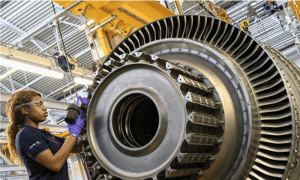US Army Selects GE for Engine Controls Technology Development
GE Aviation
| 2015/03/31 | 399 words
| AVIATION WORLD NEWS | INDUSTRY / TECHNOLOGY
The U.S. Army selected GE Aviation to perform conceptual design and trade analysis on the Rotorcraft Advanced Engine Integrated Controls System (RAEICS) program. The 24-month project will develop a conceptual design of an advanced engine control system to enable innovative, high performance propulsion capabilities for Future Vertical Lift (FVL) platforms.
RAEICS will assess innovative engine controls technologies and architectures, and explore approaches to optimally integrate the advanced engine controls system with vehicle systems and subsystems. GE will participate in the RAEICS program with Sikorsky Aircraft Corporation.
GE continues to support JMR/FVL development efforts through multiple programs to include the Future Affordable Turbine Engine (FATE) program. GE is investing in the FATE program to ensure advanced engine technology is ready when required for FVL. FATE Inlet particle separator, compressor, combustor and turbine component tests are ongoing or completed. At the same time, hardware is being manufactured and assembled for engine testing.
FATE is aimed at demonstrating a 5,000-10,000 shp-class turboshaft with an 80% increase in power-to-weight ratio, 35% reduction in specific fuel consumption, 45% lower production and maintenance costs, 20% lower development cost and 20% longer design life. GE completed its FATE detailed design review in November, 2013.
“We’re proud to build on our substantial Future Vertical Lift development work with the Army,” said Harry Nahatis, GE Aviation’s general manager of advanced turboshaft programs. “This RAEICS contract will enable GE to offer more innovative approaches to engine control systems for FVL”. In addition to technologies developed through RAEICS and FATE, GE invests $1.8B annually in advanced technologies, such as 3D aero designs, Ceramic Matrix Composite materials, and additive manufactured components.
The Army and GE are also cooperating on other advanced technology programs including the Advanced Variable Speed Power Turbine (AVSPOT), Autonomous Sustainment Technology for Rotorcraft Operations (ASTRO), Alternative Engine Concepts Design and Analysis (AECDA) programs and the Advanced Affordable Turbine Engine (AATE) .
Under the AATE effort which is demonstrating technologies applicable to the Improved Turbine Engine Program (ITEP) further development of Inlet Particle Separators is ongoing. Ensuring military rotorcraft engines have the capability to operate in severe sand and dust environments is of critical importance.
GE Aviation, an operating unit of General Electric Company (NYSE: GE), is a world-leading provider of commercial and military jet engines and components as well as integrated digital, electric power, and mechanical systems for aircraft. GE Aviation also has a global service network to support these offerings.
RAEICS will assess innovative engine controls technologies and architectures, and explore approaches to optimally integrate the advanced engine controls system with vehicle systems and subsystems. GE will participate in the RAEICS program with Sikorsky Aircraft Corporation.
GE continues to support JMR/FVL development efforts through multiple programs to include the Future Affordable Turbine Engine (FATE) program. GE is investing in the FATE program to ensure advanced engine technology is ready when required for FVL. FATE Inlet particle separator, compressor, combustor and turbine component tests are ongoing or completed. At the same time, hardware is being manufactured and assembled for engine testing.
FATE is aimed at demonstrating a 5,000-10,000 shp-class turboshaft with an 80% increase in power-to-weight ratio, 35% reduction in specific fuel consumption, 45% lower production and maintenance costs, 20% lower development cost and 20% longer design life. GE completed its FATE detailed design review in November, 2013.
“We’re proud to build on our substantial Future Vertical Lift development work with the Army,” said Harry Nahatis, GE Aviation’s general manager of advanced turboshaft programs. “This RAEICS contract will enable GE to offer more innovative approaches to engine control systems for FVL”. In addition to technologies developed through RAEICS and FATE, GE invests $1.8B annually in advanced technologies, such as 3D aero designs, Ceramic Matrix Composite materials, and additive manufactured components.
The Army and GE are also cooperating on other advanced technology programs including the Advanced Variable Speed Power Turbine (AVSPOT), Autonomous Sustainment Technology for Rotorcraft Operations (ASTRO), Alternative Engine Concepts Design and Analysis (AECDA) programs and the Advanced Affordable Turbine Engine (AATE) .
Under the AATE effort which is demonstrating technologies applicable to the Improved Turbine Engine Program (ITEP) further development of Inlet Particle Separators is ongoing. Ensuring military rotorcraft engines have the capability to operate in severe sand and dust environments is of critical importance.
GE Aviation, an operating unit of General Electric Company (NYSE: GE), is a world-leading provider of commercial and military jet engines and components as well as integrated digital, electric power, and mechanical systems for aircraft. GE Aviation also has a global service network to support these offerings.
Tags :












